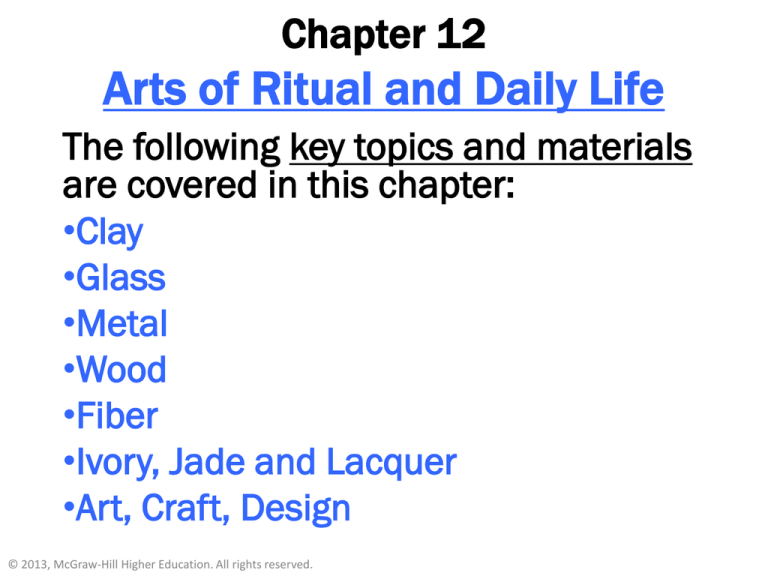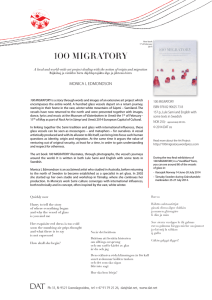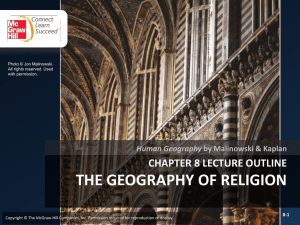
Chapter 12
Arts of Ritual and Daily Life
The following key topics and materials
are covered in this chapter:
•Clay
•Glass
•Metal
•Wood
•Fiber
•Ivory, Jade and Lacquer
•Art, Craft, Design
© 2013, McGraw-Hill Higher Education. All rights reserved.
Arts of Ritual and Daily Life
This chapter explores the context of
art as it is related to daily life. The
religious ceremonies and ritual
setting are what give definition to the
everyday objects.
© 2013, McGraw-Hill Higher Education. All rights reserved.
CLAY
Ceramics is the art of making objects
from clay. Dry clay has a powdery
consistency.
•Plastic: When clay is mixed with water
and becomes moldable.
•Firing the clay in a kiln between 1,200
and 2,700 degrees changes the chemical
composition of the clay so it is no longer
“plastic.”
© 2013, McGraw-Hill Higher Education. All rights reserved.
Key terms for this chapter include:
• ceramics
• plastic
• slab construction
• coiling
• potter’s wheel
• porcelain
© 2013, McGraw-Hill Higher Education. All rights reserved.
• glaze
• glass blowing
• stained glass
• forging
• textile
• weaving
• felting
CLAY
• Slab Construction: A building technique
where clay is rolled out into sheets and left
to harden so it can be made into
containers that will not distort.
• Coiling: The ceramists rolls out rope like
strands, coils them on top of each other,
and joins them together. (Native
Americans used burnishing technique)
• Potter’s Wheel: A rotating flat disk
mounted on a vertical shaft that helps a
ceramist shape vessels.
© 2013, McGraw-Hill Higher Education. All rights reserved.
Blackware pot, Maria and Julian
Martinez, 1939
CLAY
• Porcelain: A ceramic made from
mixing kaolin (fine white clay) with
porcelain stone.
• Glaze: Consists of powdered
minerals in water. When fired they
fuse into a nonporous glasslike
coating.
Insert visual(s).
Suggestion: 12.2 Vase
© 2013, McGraw-Hill Higher Education. All rights reserved.
Vase, China 18th century,
porcelain
Bottle in the shape of pomegranate,
Sand core glass, Egypt, 1550-1307
GLASS
Glass is a very versatile material that
consists mainly of silica (sand). When
heated, glass becomes molten and
easily shaped. The chemical
composition never changes.
Insert visual(s).
Suggestion: 12.4 Tree of Jesse
© 2013, McGraw-Hill Higher Education. All rights reserved.
GLASS
• Glass Blowing: When an artists dips
up a mass of molten glass at the
end of a metal tube and blows into
it creating an air bubble that can be
shaped, thus hollowing the vessel.
• Glass was considered a luxury product
in ancient civilizations.
© 2013, McGraw-Hill Higher Education. All rights reserved.
GLASS
• Stained Glass: Made by cutting
sheets of colored glass in various
colors and fitting them together in a
pattern; often the segments are joined
by strips of lead.
• Stained glass has been used in
cathedrals. The light passing through was
viewed as a spiritually transforming
substance.
© 2013, McGraw-Hill Higher Education. All rights reserved
Tree of Jesse, Chartes
Cathedral, 1150-70
METAL
Metal has been used to create art
as well as it has being used for
functional tools and everyday
objects from throughout history.
•Forging: When metal is shaped by
hammer blows.
Insert visual(s).
Suggestions:
12.5 pair of royal earrings
12.6 Lion Aquamanile
© 2013, McGraw-Hill Higher Education. All rights reserved.
Pair of royal earrings, India,
gold.
Lion Aquamanile, Nuremberg,
1400
WOOD
Wood is a renewable, available, easyto-work-with material. It has been
used throughout history for ritual and
daily purposes.
• Because wood is organic and vulnerable
to heat, cold, water and fire, wooden
objects from the past are rare to find.
Insert visual(s).
Suggestion: 12.7 Chair of Hetepheres
© 2013, McGraw-Hill Higher Education. All rights reserved.
Chair of Hetepheres,
Egypt, Dynasty 4,
2575-2551
Olumeye Bowls, early 20th century
FIBER
Fiber is a pliable threadlike strand.
Most naturally occurring fibers are
either animal or vegetable in origin.
•Basket weaving is a traditional women’s
art that has been used throughout the
centuries.
Insert visual(s).
Suggestions:
12.9 Feathered basket
12.11 Ardabil carpet
© 2013, McGraw-Hill Higher Education. All rights reserved.
FIBER
• Textile: An art used to create the
clothing we wear daily.
• Felting: A technique where fibers
are matted and pressed together.
• Weaving: Placing two sets of
parallel fibers at right angles and
interlacing them repeatedly.
© 2013, McGraw-Hill Higher Education. All rights reserved.
Feathered Basket, 1877
Ardabil Carpet, Persia,
1539-40
Royal tunic,
Peru, Inca, wool
and cotton, 1500.
(Draped statues
with fine textiles)
IVORY, JADE, AND LACQUER
Ivory, jade, and lacquer are
considered rarer more precious
materials and are often associated
with wealth.
•Ivory: Traditionally came from the
tusks of elephants.
•Today, the ivory trade is banned in India
and restricted in Africa.
© 2013, McGraw-Hill Higher Education. All rights reserved.
Arm ornament, Yoruba, 16th century
Lidded saltcellar, Sapi artist, 1516th century,
IVORY, JADE, AND LACQUER
• Jade: A common name for two materials:
nephrite and jadeite. It ranges in color
from brown to green, and is primarily
found in Asia and Central America.
• Lacquer: Made from the sap of a tree
originally only found in China. It creates a
glasslike coating over wood and takes up
to 30 coats to create a substantial layer.
© 2013, McGraw-Hill Higher Education. All rights reserved.
Vase in form of two carp, China, 18th century, Green
jade.
Tiered Picnic Box, Japan, late 17th century,
lacquer, gold, silver powder, shell
ART, CRAFT, DESIGN
Decorative arts were segregated
from the fine arts (painting and
sculpture) and for many years were
termed as “crafts”.
•The Arts and Crafts movement
flourished during the 19th and early 20th
centuries. It heightened the public
awareness of handmade objects and
traditional skills.
© 2013, McGraw-Hill Higher Education. All rights reserved.
Gustav Stickley’s Craftsman Workshop, table, 1910-12,
oak, leather and brass
Night Street Chaos, Toots
Zynsky, 1998, Fused glass
Shell Chest, Judy Kensley
McKie, 2000. Carved and
constructed.
Ini 3, Maria Nepomeuceno,
2009, nylon rope and beaded
necklaces.
Sasa, El Anatsui, 2004,
aluminum and copper wire
Iago’s Mirror, Fred Wilson,
2009, Murano glass,
OneShot, Patrick Jouin, 2006.
Laser-sintered nylon
Arts of Ritual and Daily Life: SUMMARY
Key Topics, Materials, and Terms:
•Clay: ceramics, plastic, slab construction,
coiling, potter’s wheel, porcelain, glaze
•Glass: glass blowing, stained glass
•Metal: forging
•Wood
•Fiber: textile, weaving, felting
•Ivory, Jade and Lacquer
•Art, Craft, Design
© 2013, McGraw-Hill Higher Education. All rights reserved.












